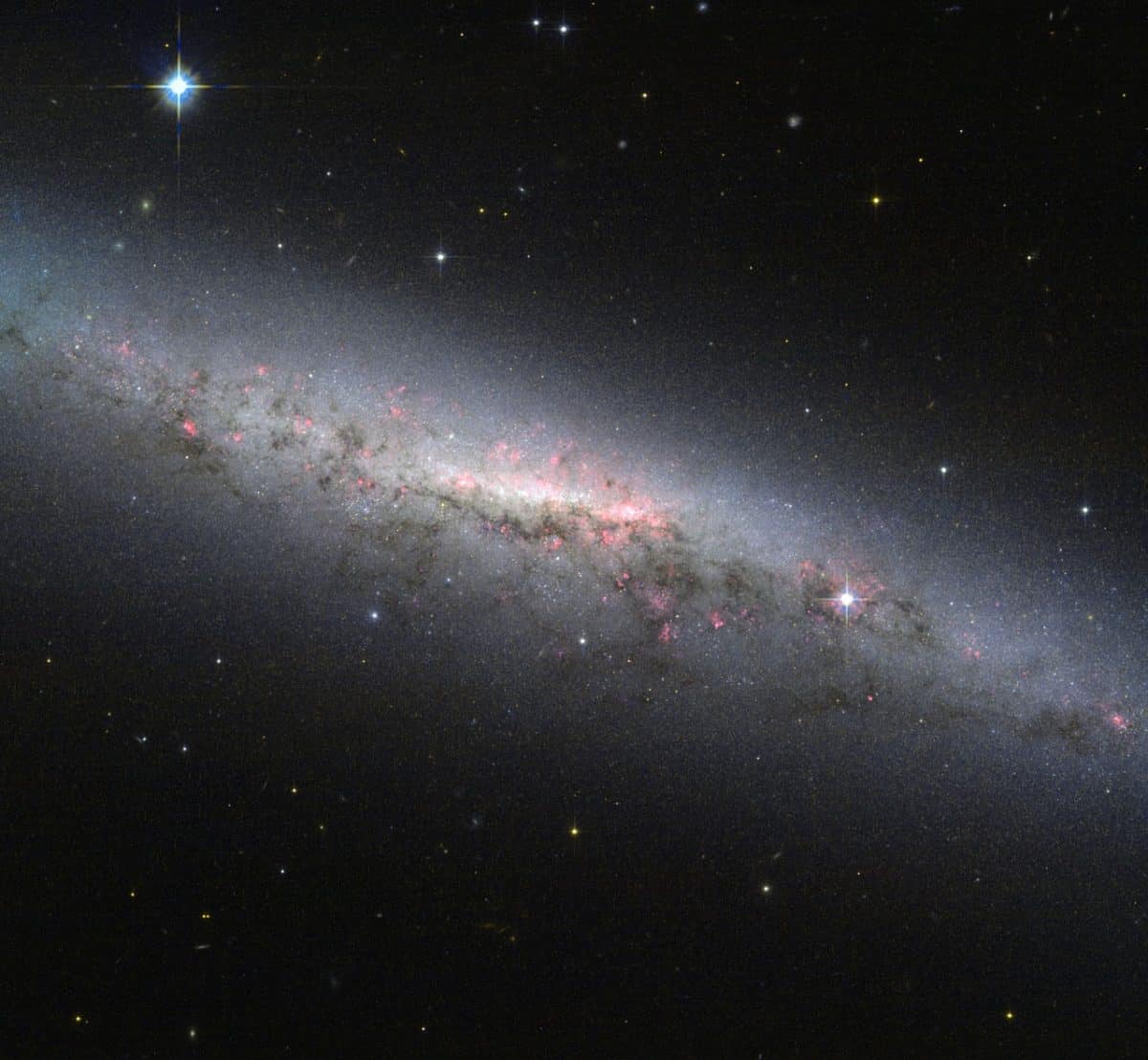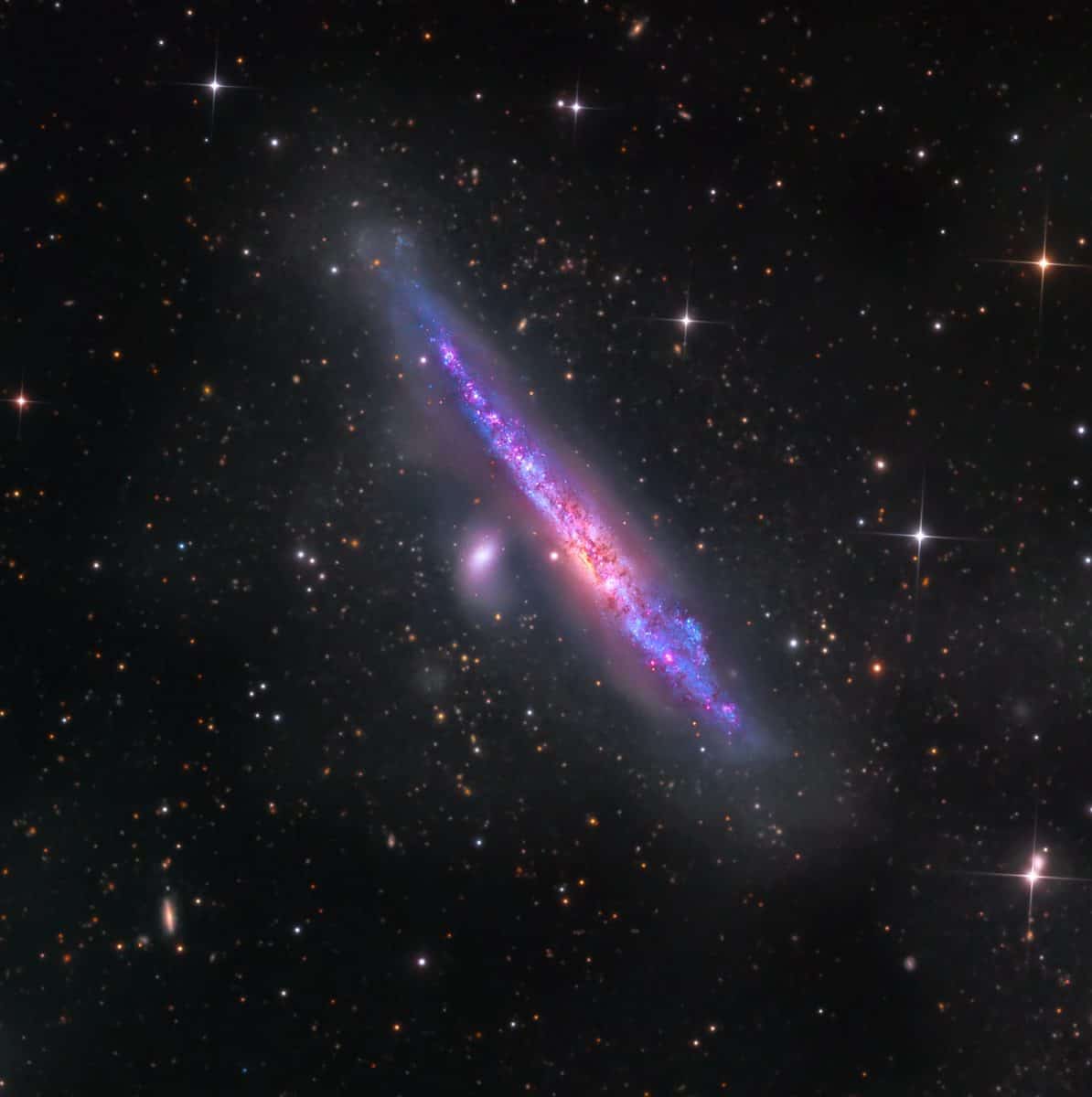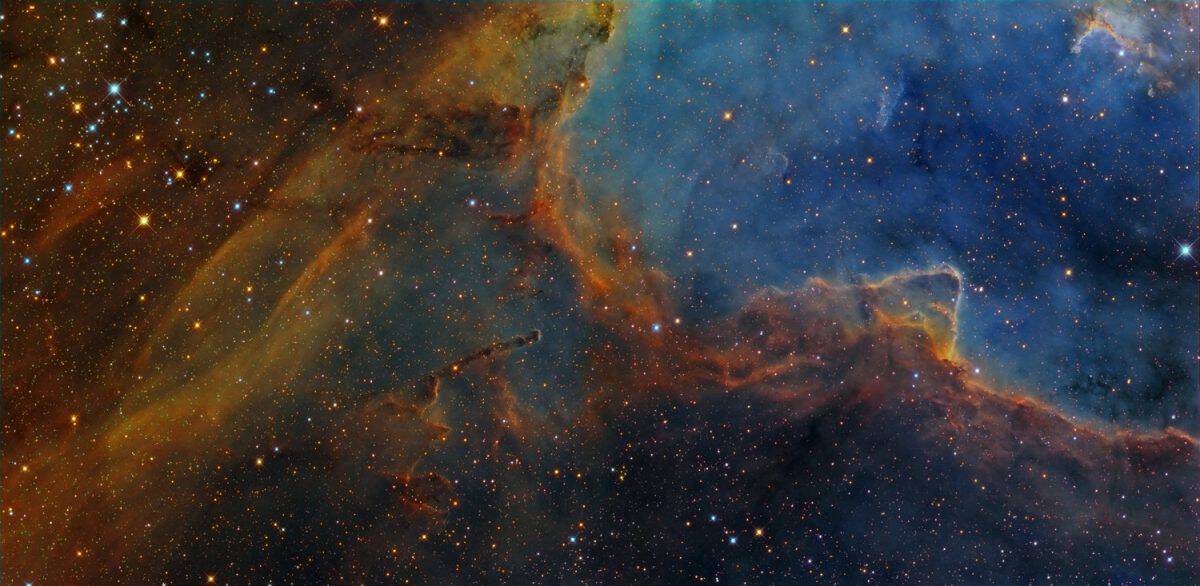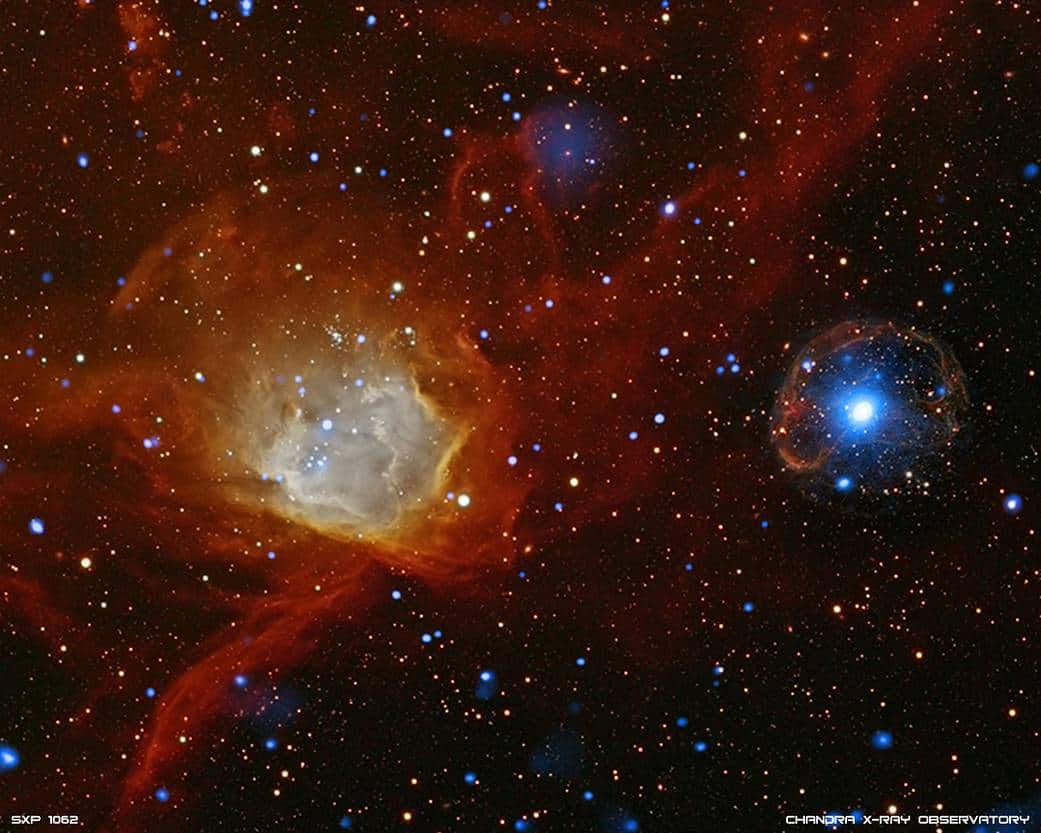Blog
A gorgeous new photo by the Hubble Space Telescope confirms that a faraway spiral galaxy is indeed churning out new stars at a rapid rate.
The new Hubble image captures a galaxy called NGC 7090, which is found about 30 million light-years from Earth in the southern constellation Indus (The Indian). The edge-on shot shows the galaxy’s disc and bulging central core — which is likely full of cool, relatively old stars — as well as a number of pinkish regions scattered throughout NGC 7090.
These pink areas reveal the presence of huge clouds of hydrogen gas, researchers said. Such clouds are the raw materials of which stars are made, providing striking visual confirmation of several recent studies that have classified NGC 7090 as a star-forming galaxy.
more...Larry Young (also known as Khalid Yasin [Abdul Aziz]; 7 October 1940 in Newark, New Jersey – 30 March 1978 in New York City) was an American jazz organist and occasional pianist. Young pioneered a modal approach to the Hammond B-3 (in contrast to Jimmy Smith‘s soul jazz style). However, he did also play soul jazz, among other styles.
Young played with various R&B bands in the 1950s before gaining jazz experience with Jimmy Forrest, Lou Donaldson, Kenny Dorham, Hank Mobleyand Tommy Turrentine. Recording as a leader for Prestige from 1960, Young made a number of soul jazz discs, Testifying, Young Blues and Groove Street. When Young signed with Blue Note around 1964, his music began to show the marked influence of John Coltrane. In this period, he produced his most enduring work. He recorded several times as part of a trio with guitarist Grant Green and drummer Elvin Jones, occasionally augmented by additional players; most of these albums were released under Green’s name, though Into Somethin’ (with Sam Rivers on saxophone) became Young’s Blue Note debut. Unity, recorded in 1965, remains his best-known album; it features a front line of Joe Henderson and the young Woody Shaw. Subsequent albums for Blue Note (Contrasts, Of Love and Peace, Heaven On Earth, Mother Ship) also drew on elements of the ’60s avant-garde and utilised local musicians from Young’s hometown of Newark. Young then became a part of some of the earliest fusion groups: first on Emergency! with the Tony Williams Lifetime (with Tony Williams and John McLaughlin) and also on Miles Davis‘s Bitches Brew. His sound with Lifetime was made distinct by his often very percussive approach and often heavy use of guitar and synthesizer-like effects. He is also known for a jam he recorded with rock guitarist Jimi Hendrix, which was released after Hendrix’s death on the album Nine to the Universe.
more...Mel Brown (October 7, 1939 – March 20, 2009) was an American-born blues guitarist and singer.
Brown was nominated for a Juno Award in both 2001 and 2002.
For many years in the 1980s and 1990s, Brown was a prominent member of the house band at Antone’s Night Club in Austin, Texas.
Brown died aged 69, on March 20, 2009, in Kitchener, Ontario, of complications from emphysema.
One of his most celebrated tracks is the 11+ minute guitar solo, “Eighteen Pounds of Unclean Chitluns”, which is on I’d Rather Suck My Thumb(1970), and was reissued as the lead track (and title) on a BluesWay Records collection released in 1973.
A documentary film, Love Lost & Found: The Story of Mel Brown directed by Sean Jasmins for Blue Fusion Productions was granted a theatrical release in 2014.
more...Jonathan David Samuel Jones (October 7, 1911 – September 3, 1985) was an American jazz drummer. A band leader and pioneer in jazz percussion, Jones anchored the Count Basie Orchestra rhythm section from 1934 to 1948. He was sometimes known as Papa Jo Jones to distinguish him from younger drummer Philly Joe Jones.
Born in Chicago, Illinois, Jones moved to Alabama, where he learned to play several instruments, including saxophone, piano, and drums. He worked as a drummer and tap-dancer at carnival shows until joining Walter Page‘s band, the Blue Devils in Oklahoma City in the late 1920s. He recorded with trumpeter Lloyd Hunter‘s Serenaders in 1931, and later joined pianist Count Basie‘s band in 1934. Jones, Basie, guitarist Freddie Green and bassist Walter Page were sometimes billed as an “All-American Rhythm section,” an ideal team. Jones took a brief break for two years when he was in the military, but he remained with Basie until 1948. He participated in the Jazz at the Philharmonic concert series.
He was one of the first drummers to promote the use of brushes on drums and shifting the role of timekeeping from the bass drum to the hi-hatcymbal. Jones had a major influence on later drummers such as Buddy Rich, Kenny Clarke, Roy Haynes, Max Roach, and Louie Bellson. He also starred in several films, most notably the musical short Jammin’ the Blues (1944).
https://www.youtube.com/watch?v=z8SQzu5qNNM
more...Mansi people live in Siberia and speak finno-ugric Mansi language.
more...https://www.youtube.com/watch?v=FQo8r3f9tsA
more...https://www.youtube.com/watch?v=FQo8r3f9tsA
more...Taken from DGRO Rancho Hidalgo Animas, New Mexico
14.5″ RCOS F8 Apogee U16M High Cooling.
Luminance 1200 1×1, RGB 1×1 20 min subs, Red 220
Green 200, Blue 240
NGC 4631 is a big beautiful spiral galaxy. Seen edge-on, it lies only 25 million light-years away in the well-trained northern constellation Canes Venatici. The galaxy’s slightly distorted wedge shape suggests to some a cosmic herring and to others its popular moniker, The Whale Galaxy. Either way, it is similar in size to our own Milky Way. In this sharp color image, the galaxy’s yellowish core, dark dust clouds, bright blue star clusters, and red star forming regions are easy to spot. A companion galaxy, the small elliptical NGC 4627 is just above the Whale Galaxy. Faint star streams seen in deep images are the remnants of small companion galaxies disrupted by repeated encounters with the Whale in the distant past. The Whale Galaxy is also known to have spouted a halo of hot gas glowing in X-rays.
more...Mark Whitfield (born October 6, 1966) is an American jazz guitarist.
Whitfield was born in Lindenhurst, New York. He is probably better known for his recordings as bandleader for both the Verve and Warner Bros. Records record labels. He has worked with Jack McDuff, Jimmy Smith, Courtney Pine and Nicholas Payton, Chris Botti, among others.
In 2000, Whitfield released an instructional guitar video titled Mark Whitfield: Star Licks Master Sessions, for Star Licks Productions.
On December 21, 2012 Mark played live with the Dave Matthews Band on two of their songs, “Mercy” and “Crash Into Me“, at a concert at the Barclay’s Center in Brooklyn, New York. He recently also reprised his accompaniment on two occasions during the 2013 summer tour again with “Mercy” (June 8, 2013; Hartford, CT) and with “If Only” and “Crash Into Me” (July 13, 2013; Hershey, PA).
more...Millicent Dolly May Small, CD (born 6 October 1946), is a Jamaican singer-songwriter, best known for her 1964 recording of “My Boy Lollipop“.
Small was born at Gibraltar in Clarendon, Jamaica, the daughter of a sugar plantation overseer. Like many Jamaican singers of the era, her career began by winning the Vere Johns Opportunity Hour talent contest, which she won at the age of twelve. Wishing to pursue a career as a singer she moved to live with relatives in Love Lane in Kingston. In her teens, she recorded a duet with Owen Gray (“Sugar Plum”) in 1962 and later recordedwith Roy Panton for Coxsone Dodd‘s Studio One record label as ‘Roy and Millie’.They had a local hit with “We’ll Meet”.
more...Little Sonny (born Aaron Willis, October 6, 1932, Greensboro, Alabama) is an American electric blues harmonica player, singer and songwriter.His early mentor and inspiration was Sonny Boy Williamson II. Nevertheless, Little Sonny stated that his nickname was originated by his mother: “[She] called me ‘Sonny boy’ from the time I can remember.” He has released eight albums, including three for a subsidiary of Stax Records. His 1973 release, Hard Goin’ Up, reached the Top 50 in the Billboard R&B chart.
Willis was born in 1932 and raised solely by his mother. He relocated to Detroit in 1953. He had no real interest in music, he said, “But then I saw Sonny Boy Williamson II.” Willis was “spellbound at the way he played. After the show I went home and practiced for hours. Every day after that I would practice until I got the sound I wanted.” His daytime job was working in a used car lot.
His first professional appearance was at the Good Times Bar in Detroit, playing in Washboard Willie‘s backing group. He put together his first band in March 1956. For the following fifteen years he performed in numerous Detroit clubs, often boosting his earnings by photographing customers between his performances on stage. He often performed with John Lee Hooker, Eddie Kirklandand Baby Boy Warren.
more...NGC 1027 is an open cluster in the constellation Cassiopeia. It was discovered by William Herschel in 1787. It is visible at the eastern part of the constellation, between two emission nebulae, the Heart and Soul Nebula. However, it is not physically associated with the two nebulae, lying in the foreground, about 3,000 light years away from the Solar System. The apparent magnitude of the cluster is 6.7 and can be seen with 10×50 binocularsaround a 7th magnitude star, which is not however member of the cluster. The brightest member of the cluster has apparent magnitude 9,3
The Heart Nebula, IC 1805, Sharpless 2-190, lies some 7500 light years away from Earth and is located in the Perseus Arm of the Galaxy in the constellation Cassiopeia. It was discovered by William Herschel on 3 November 1787. This is an emission nebula showing glowing ionized hydrogengas and darker dust lanes.
The very brightest part of this nebula (the knot at the western edge) is separately classified as NGC 896, because it was the first part of this nebula to be discovered.
The nebula’s intense red output and its configuration are driven by the radiation emanating from a small group of stars near the nebula’s center. This open cluster of stars known as Melotte 15 contains a few bright stars nearly 50 times the mass of our Sun, and many more dim stars that are only a fraction of our Sun’s mass.
more...Clifton Anderson (born October 5, 1957) is an American jazz musician, a trombone player. He grew up surrounded by music. His father was a church organist /choir director, and his mother a singer and pianist. It was no surprise that Clifton exhibited an affinity for music at an early age. When he was just seven years old he got his first trombone, a gift from his famous uncle Sonny Rollins.
Clifton attended the prestigious Fiorello LaGuardia High School of Music and Art. In 1974, he spent one year at the State University of New York at Stony Brook studying under Simon Karasick and Dave Schechter. He continued his education at the Manhattan School of Music, and graduated in 1978 with a Bachelor of Music degree.
At The Manhattan School, he studied under the Metropolitan Opera trombonist John Clark. There he also met and befriended talented musicians including Angela Bofill and the late Kenny Kirkland.
While at Manhattan School of Music, Clifton began freelancing around New York City, making record dates and sitting in at clubs. He participated in jazz organizations like the Muse, the CBA Ensemble and later Barry Harris’s ensemble workshops on 8th Avenue. Clifton made his first record date with Carlos Garnett in 1976. By his senior year, at Manhattan he had established himself as one of the young “in demand” trombonists in New York.
more...James Blanton (October 5, 1918 – July 30, 1942) was an American jazz double bassist. Blanton is credited with being the originator of more complex pizzicato and arco bass solos in a jazz context than previous bassists.
Blanton was born in Chattanooga, Tennessee. He originally learned to play the violin, but took up the bass while at Tennessee State University, performing with the Tennessee State Collegians from 1936 to 1937, and during the vacations with Fate Marable.Blanton left university in 1938 to play full-time in St Louis with the Jeter-Pillars Orchestra. Blanton joined Duke Ellington‘s band in 1939. On November 22 of that year, Blanton and Ellington recorded two tracks – “Blues” and “Plucked Again” – which were the first commercially recorded piano–bass duets. Further duet recordings were made in 1940, and Blanton was also featured in orchestra tracks. “Blanton also took part in a few of the informal jam sessions at Minton’s Playhouse in New York that contributed to the genesis of the bop style.” He had to leave Ellington’s band near the end of 1941, because of poor health.
more...World Music on Flamenco Fridays with Miguel de los Reyes
Poco a poco Miguel de los Reyes consiguió montar su propio espectáculo y trabajar mano a manos con figuras consagradas como Concha Piquer o Estrellita Castro entre otros.
Igualmente montó el Ballet de Arte Español compuesto de cantaores, bailaoras, palmeros, y una gran cantidad de primeras figuras de artistas a los que él mismo dirigía, con gran refinamiento y disciplina, algo característico en él, sello que marcarían todos sus espectáculos. De entre ellos cabe destacar Suspiros de España, que en tres versiones diferentes dieron la vuelta al país con gran éxito.
En los años 50 y 60 se marcha a Argentina donde rueda varias películas como “El mucamo de la niña” o “La guitarra de Gardel” y “El amor brujo”, teniendo como pareja a Carmen Sevilla y Ana Esmeralda respectivamente.
more...Astronomers have discovered a very slowly rotating X-ray pulsar still embedded in the remnant of the supernova that created it. This unusual object was detected on the outskirts of the Small Magellanic Cloud, a satellite galaxy of the Milky Way, using data from a number of telescopes, including ESA’s XMM-Newton. A puzzling mismatch between the fairly young age of the supernova remnant and the slow rotation of the pulsar, which would normally indicate a much older object, raises interesting questions about the origin and evolution of pulsars.
The spectacular supernova explosion that marks the end of a massive star’s life also has an intriguing aftermath. On the one hand, the explosion sweeps up the surrounding interstellar material creating a supernova remnant that is often characterised by a distinctive bubble-like shape, on the other hand, the explosion also leaves behind a compact object – a neutron star or a black hole.
Since supernova remnants shine only for a few tens of thousands of years before dispersing into the interstellar medium, not many compact objects have been detected while still enclosed in their expanding shell.
An international team of astronomers has now discovered one of these rarely observed pairs, consisting of a strongly magnetised, rotating neutron star – a pulsar – surrounded by the remains of the explosion that generated it.
The newly found pulsar, named SXP 1062, is located at the outskirts of the Small Magellanic Cloud (SMC), one of the satellite galaxies of the Milky Way. SXP 1062 is an X-ray pulsar, part of a binary system in which the compact object is accreting mass from a companion star, resulting in the emission of copious amounts of X-rays.
The astronomers first detected the pulsar’s X-ray emission using data from ESA’s XMM-Newton as well as NASA’s Chandra space-based observatories. A later study of optical images of the source and its surroundings revealed the bubble-shaped signature of the supernova remnant around the binary system.
“The most interesting aspect of this pulsar is possibly its extremely long period – 1062 seconds – which makes it one of the slowest pulsars on record,” comments Lidia Oskinova from the Institute for Physics and Astronomy in Potsdam, Germany, coordinator of the team that analysed the X-ray data.
Pulsars rotate quite rapidly in their early stages, with periods of only a fraction of a second, and then slow down gradually with age. “Slowly spinning pulsars are particularly difficult to detect. Only a few with periods longer than a thousand seconds have been observed to date,” she adds.
To further investigate the binary system hosting this unusually slow pulsar, the team looked at the source at optical wavelengths, conducting follow-up observations with the European Southern Observatory’s Very Large Telescope (VLT) and inspecting archival and newly acquired images from the Cerro Tololo Inter-American Observatory (CTIO).
“The VLT spectra confirm that the pulsar is accreting mass from a massive, hot, blue ‘Be’ star. The two bodies form a Be/X-ray binary, a class of X-ray binary that’s very common in the SMC,” explains Vincent Henault-Brunet, PhD student at the Institute of Astronomy, University of Edinburgh, UK.
Henault-Brunet is the first author of a paper in which these results are reported. It will appear as a letter in the January 2012 issue of the Monthly Notices of the Royal Astronomical Society.
The result relies on the combined power of a number of complementary observatories.
“XMM-Newton’s large effective area was instrumental in achieving high-sensitivity observations of the pulsar and the supernova remnant around it over a broad range of X-ray wavelengths,” says Norbert Schartel, ESA’s XMM-Newton Project Scientist.
These data were combined with Chandra’s, which probe the source at a higher angular resolution, albeit with lower sensitivity, to arrive at a comprehensive picture of the pulsar’s X-ray emission.
The optical images, on the other hand, revealed the bubble-shaped nebula that harbours the binary system. This nebula appears to be the remnant of the supernova from which the pulsar itself originated.
“Not many pulsars have been observed within their supernova remnant, and this is the first clear example of such a pair in the SMC,” comments Henault-Brunet.
Opportunities like this enable astronomers to study the complex relationship between the expanding remains of stellar explosions and the compact objects they leave behind.
The case of SXP 1062 is particularly puzzling because of an apparent mismatch between the ages of the supernova remnant and that of the pulsar.
“Extremely slow rotation in pulsars normally points to old objects – something that doesn’t quite agree in this case with the fairly young age of the supernova remnant, which ranges between 20,000 and 40,000 years,” notes Oskinova.
The reason for the slow rotation of this pulsar remains a mystery: if it was born with a normal spin rate, how could it slow down to this extent in such a short time? Alternatively, was the pulsar born with a much slower rotation period than typically expected?
Since the pulsar is located in the Wing of the SMC, an interesting peripheral region of this galaxy that is characterised by low density of stars, gas and dust, as well as by low metallicity, the environment may have played a role by affecting the properties of the pulsar’s progenitor star before its demise in a supernova explosion.
The rich data set that this team of astronomers have gathered may yet contain an explanation for this peculiar case. “Our plan is to fully mine the X-ray data to study the system’s variability in greater detail, and further study the optical spectra to investigate the properties of the companion star,” says Oskinova. “We can’t wait to see what the data tell us.”
Notes for editors The findings presented here report the discovery of a Be/X-ray binary system consisting of a pulsar, SXP 1062, and a companion ‘Be’ star, 2dFS 3831, located in the Wing of the Small Magellanic Cloud (SMC).
The study is based on complementary data from ESA’s XMM-Newton and NASA’s Chandra X-ray observatories. XMM-Newton’s large effective area was key to high-sensitivity observations of the pulsar and supernova remnant over a broad range of X-ray wavelengths, while the Chandra data provide higher angular resolution, albeit at a lower sensitivity.
The Fibre Large Array Multi Element Spectrograph (FLAMES) on ESO’s Very Large Telescope was used for follow-up optical spectroscopy.
Archival images from the Magellanic Cloud Emission-Line Survey (MCELS) conducted at NOAO’s Cerro Tololo Inter-American Observatory, as well as newly acquired images, were also used to study this portion of the sky in a number of emission lines: the H-alpha line of neutral hydrogen and two forbidden lines of oxygen [OIII] and sulphur [SII]. These lines trace emission from some of the elements produced during supernova explosions, making them excellent diagnostic tools for the study of supernova remnants.
An X-ray pulsar is one component of a binary system where the X-ray emission is produced by accretion of matter from the stellar companion onto the pulsar. Such pulsars generally have longer periods – typically between 1 and several hundred seconds – than the more common radio pulsars.
Neutron star X-ray binaries are classified into high-mass X-ray binaries (HMXB) and low-mass X-ray binaries (LMXB) depending on the mass of the companion star. HMXB are further divided into supergiant X-ray binaries (SGXB) and Be/X-ray binaries (BeXB). Be/X-ray binaries consist of a neutron star and a ‘Be’ companion star – a B-type star characterised by prominent hydrogen emission lines in its spectrum. Virtually all known Be/X-ray binaries harbour X-ray pulsars.
The SMC, a satellite galaxy of the Milky Way, is known to host about 50 HMXB – a surprisingly large population considering that its mass is only a few per cent of that of the Milky Way, in which about 70 HMXB are known to exist to date. All but one of the HMXB detected in the SMC are BeXB.
more...More Posts
- Nothando Zulu doesn’t separate the artist from the community
- Chris Johnson: He Gets Paid by the Rest
- Johnna Morrow: Survival Through Diversification
- Kevin Washington: Jumping Out of the Box
- Milo Fine: Composing in Real Time
- Homewood Studios: You Do Not Have to Leave the Community to Find Great Art
- David Harris: Music Builds Community
- Jamie Carter: Music is a Reflection of Life
- Merlin Brunkow-Bronco Keeps on Playing
- Scott Nieman-Music Brings People Together Locally and Globally
- KARIBUNI
- Maqam
- Ancestor Energy
- Maroons
- Mojo Roots
- Voices of Sepharad
- Beau Koo Jacks
- World Cafe International
- Mojo Roots: Prakriti’s Kiss
- Ancestor Energy: Allwhere



